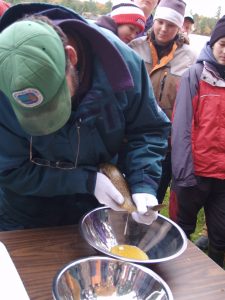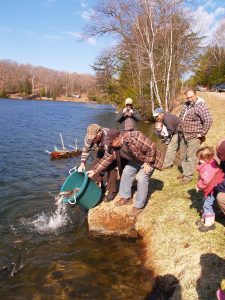
THE NORTH HASTINGS COMMUNITY FISH HATCHERY
November 28, 2007, the North Hastings Community Fish Hatchery (NHCFH) was but a hole in the ground. Come January 29, 2009, it was an up and running state of the art fish hatchery that was home to 8000 “eyed” lake trout, received late in December 2008 and 5400 yearling trout received early in 2009 from local lakes Ashby and Weslemkoon. The fish had been cared for at the Haliburton Highlands Outdoor Association’s hatchery until the NHCFH could take delivery. In fact there were still 4000 trout in Haliburton as the NHCFH didn’t want to put “all its eggs in one basket” lest something went wrong.
The hatchery released 850 trout into L’Amable Lake in the spring of 2008. “That’s all we had at the time,” said NHCFH Board member Dennis Le Feuvre. “But it was a start.” On April 24, 2009, volunteers of the NHCFH released 3000 lake trout, approximately 9 inches long and just shy of one-quarter pound in local lakes, including L’Amable, as part of a continuing 5 year program. They were the first to be raised under the new hatchery roof. The other recipient lakes were decided upon following discussion at the hatchery’s annual meeting.
The hatchery raises a locally adapted indigenous lake trout species unique to the area, generically named the “Jewel” by Cobourg resident Bob Sumner in a “name the fish” contest with evident reference to Bancroft’s motto – The Mineral Capital of Canada.
“Local Fish For Local Lakes” is the hatchery’s motto as it hopes to rehabilitate a self-sustaining local lake trout and to revitalize the area’s recreational lake trout fishery. Interestingly, although hatched within a day of each other, the Weslemkoon yearling were noticeably larger.
“That’s due to feeding,” explained hatchery Director Denis Brown. The Ashby trout are smaller because they were hand fed whereas the Weslemkoon trout were fed by an automatic feeder that dispensed food over a 12 hour period apparently producing a larger fish, faster. Brown added that there is much less food waste with the auto feeder.
At the outset I mentioned that this facility is “state of the art.” To their knowledge, Le Feuvre and Brown said that this is the only private re-circulation system in Ontario. But “it’s quite common in Europe,” said Le Feuvre who spent countless hours researching on the internet. “That makes us distinctive,” he added. Fleming College, with whom the hatchery is associated, has an older model recirculation system as well. What are the benefits of such as system?
“It is more efficient, generates less pollution, and requires a minimal water supply,” said LeFeuvre.
“More fish; less water,” summed up Brown.
The hatchery’s agreement with the MNR is for 10,000 lake trout eggs per year. Up to 20,000 fish can be at the hatchery. “Lake trout are a considerable challenge,” said Le Feuvre. “We keep them for 18 months so they can grow to a larger size. Potentially, we can have two years of fish in the hatchery at a given time just prior to stocking.”
Another positive distinction is that most of the $600,000+ cost of the hatchery has been spent, as a part of local economic development, locally. “We had to go elsewhere to purchase the re-circulation system,” said Le Feuvre. “Otherwise the money has all been invested in the area.”
This is entirely an all volunteer operation and as an incorporated non-profit hatchery that is also a federally registered charity, all donations are tax deductible. “We have 12 core volunteers and are training another 6 at this time,” said Le Feuvre.
During the fall of 2009, while most of us were recovering from our bout with Thanksgiving turkeys and all the trimmings, volunteers from the NHCFH and MNR fisheries employees were out on frigid Lake Weslemkoon (it means “bank beaver”) setting trap nets in search of more “Jewels.” Tuesday, October 13 was a classic winter wonderland – postcard perfect but not exactly ideal for a day on the lake. It was more suitable to reading a good book in front of a fireplace. But that was the day they set their trap nets because on Wednesday the plan was for several volunteers, including two classes from North Hastings High School, to assist milking live lake trout males and mixing the sperm with the eggs gently persuaded from the females. Actually these “Jewels” are glacial relics original to the lake, and area, whose ancestry has been traced back some 10,000 years. That is a lot of history.
By nature, the “Jewels” are not large. Any fish in the lower teens (i.e. 13 lbs.) is considered big. (Compared to the lake trout in the N.W.T.s these are minnows.) But they are “ours” and they are not only surviving – they are thriving – especially important in these days of bizarre changing weather patterns. (Cynics may notice that the term “global warming” is fast fading in favour of “climate change” as in “if I had wanted summers that were cold and wet I would have moved to British Columbia.”)
Although the thermometer read -3C the fisheries crew was on the lake at first light collecting adult lake trout. A cold onshore breeze and an overcast sky did little to warm the outing. The crew returned at 9:30 a.m., just as the school bus arrived. The Northern Outdoors Studies class and a grade 9 environmental class were both available to learn and to lend a helping hand. Literally, this was a “hands on” day of schooling. Of course they probably would have preferred sitting in math class but…
The fish ranged in age from 5-15 years and the day’s objective was to gather 10,000 fertilized eggs for the hatchery, ultimately to be released in area lakes.
The first fish was “green” meaning she had nothing to offer whereas the second hen trout deposited her eggs freely while she rested securely in the tub of water in which clove oil had been added as a natural sedative. MNR Biologist Dave Flowers demonstrated how to gently liberate the eggs. Then he took the male and added the sperm to the eggs that had been collected in a stainless steel bowl. When doing this with walleye you need a feather to mix the sperm/eggs but with lake trout one simply “sloshes” them about for the mix. Lake trout sperm isn’t as adhesive as the walleye’s.
Flowers demonstrated how to tag each fish before sending it to recovery in a fresh water bath and release into the lake.
“No shore lunch to-day,” quipped LeFeuvre.
They had their quota by 2:00 p.m. and had to let the eggs harden for an hour before disinfecting them. “We had the eggs home and in the combi tank trays around 4:30 p.m.”, said LeFeuvre. In all they had accumulated 10,200 fertilized eggs. Then, on Thursday, they returned to the lake. MNR Technician Colin Higgins provided more fish for an additional 2000 eggs providing some “wiggle room” (LeFeuvre). “Once again Mother Nature was kind to us and we will try to do our part from here on,” said LeFeuvre.
Now the Mineral Capital has two more gems – the hatchery and the “Jewel.” Anyone interested in a tour or wishing to volunteer can call 1.613.332.4084. For more information and photos goto: www.fishhatchery.ca. Presently, there are 100 lake trout lakes in the Bancroft/Mazinaw area of which 60 are considered native lake trout lakes.

Photos: 2. Jewels being released. 2a. The NHCFH. 2b. Mix the sperm with the eggs.
